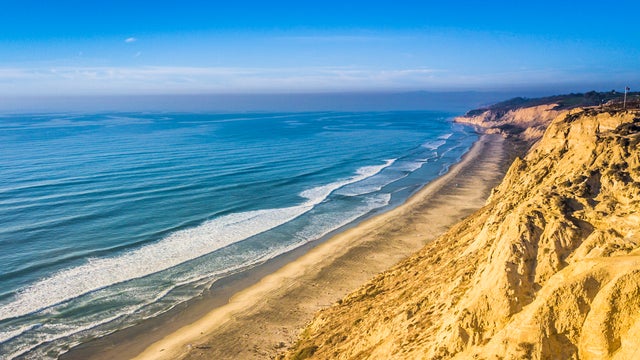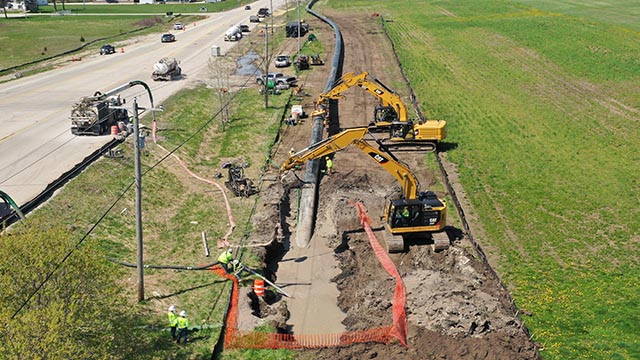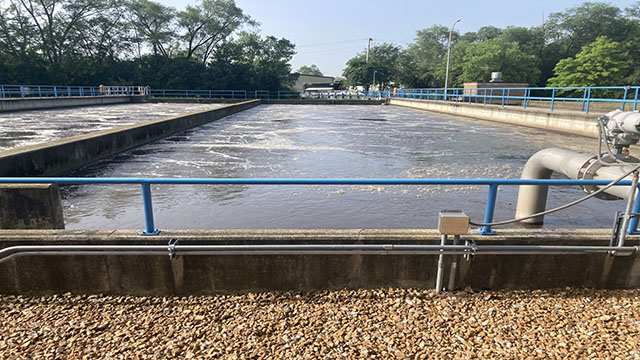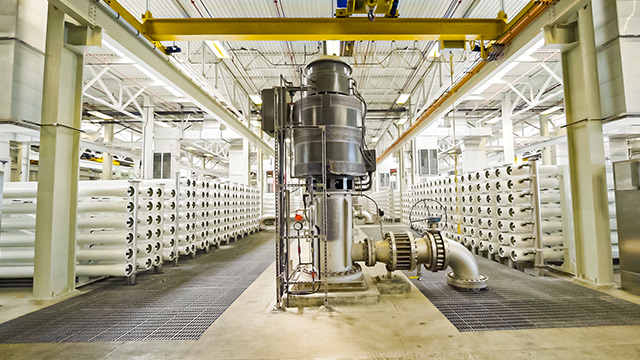In a column last December for the World Economic Forum, Austin Alexander — vice president of sustainability and social impact for Xylem, a leader in water technology solutions — pressed water utilities to proactively get greener and bolster their resilience and sustainability against the growing threat of climate change. Through innovation, Alexander wrote, “the sector can be a powerful example for other industries looking to pick up the pace in the race to net-zero.”
That impassioned advocacy for action came as the U.S. water sector continues awakening to the challenges of climate change and the more frequent and severe droughts, wildfires and flooding it presents, testing the resilience of water systems.
Consider this: When Black & Veatch first launched its annual assessment of the U.S. water industry in 2012, there were no mentions of climate change or “decarbonization,” the effort to lower carbon footprints. Now — in this year’s report, based on a survey with more than 450 responses from U.S. water industry stakeholders — climate adaptation and resilience continue their ascension in relevance, closing out the sector’s top five perceived top challenges behind only aging infrastructure, the workforce, funding and regulation.
Given that growing awareness, where exactly does the industry stand on addressing climate change through such things as predictive modeling, risk mitigation and investment in asset hardening? Black & Veatch’s 2023 Water Report shows those results as mixed.
Climate Change: The Inescapable Reality
As the U.S. Environmental Protection Agency (EPA) submits, effects of climate change on water quality and availability are far-ranging, considering the impacts of increasing pollutant and sediment runoff as well as the potential of lowering water supplies due to drought and saltwater intrusion.
From extreme flooding in coastal areas to wind driven wildfires and soil-parching droughts in the West, evidence of destructive climate change abounds. And the industry appears to understand it.
According to Black & Veatch’s survey, six in 10 respondents (61 percent) asked to rank their top three concerns about the impact of climate change cited changing precipitation patterns and floods, followed by drought (53 percent), the cost of disruptive events (46 percent) and aging infrastructure (42 percent) (Figure 24). Rising temperatures drew a distant 17 percent of the responses, slightly ahead of wildfires (16 percent) and sea level rise (12 percent).
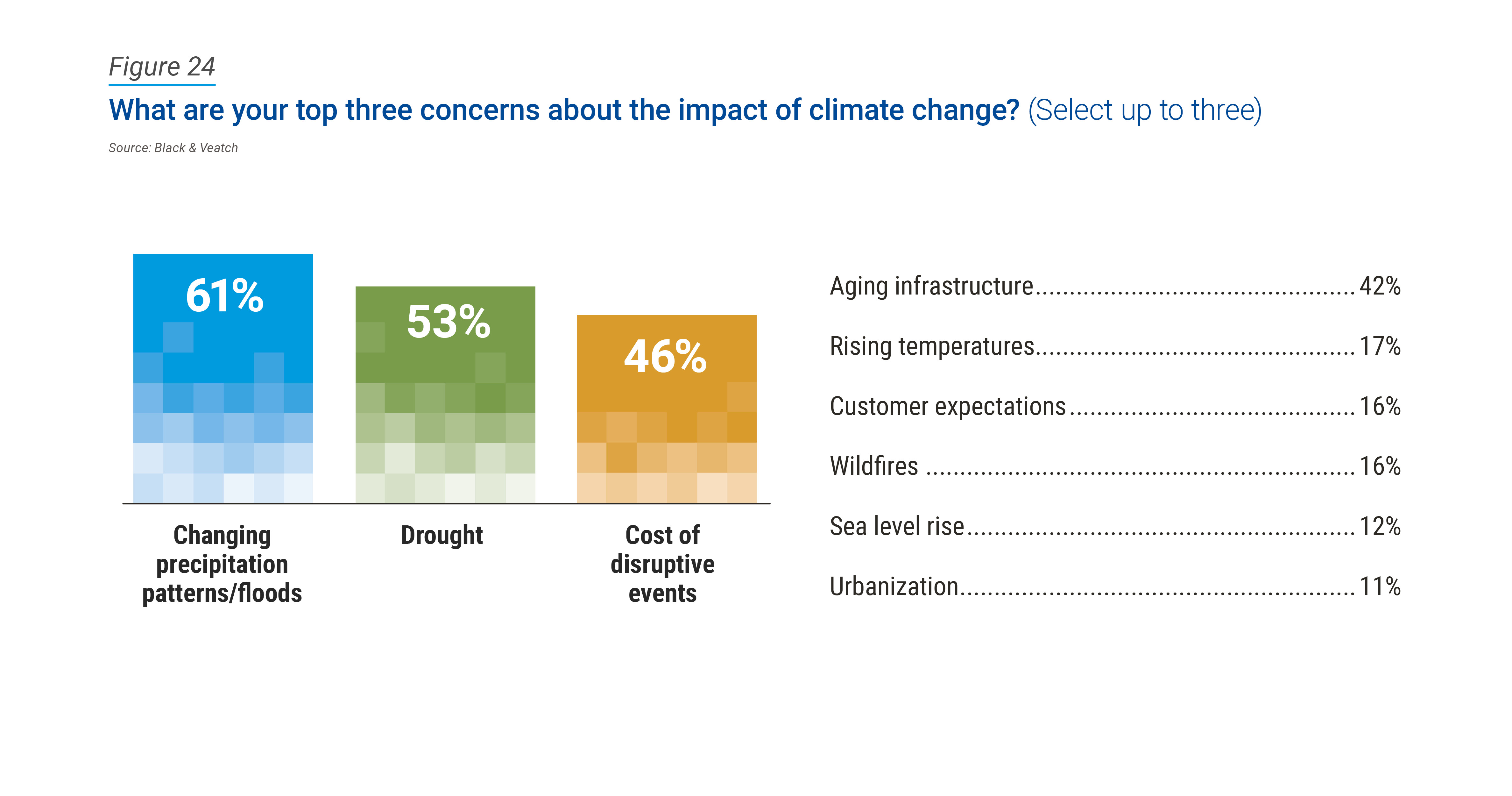
Drought certainly was top of mind for California Gov. Gavin Newsom, who in February signed an executive order meant to safeguard the state’s water supplies after a string of heavy, drenching winter storms gave way to unseasonably dry conditions across the nation’s most populous state. Among other things, the order was intended to help expand the state’s capacity to capture storm runoff during wet years by accelerating groundwater recharge projects.
“The state can expect continued swings between extreme wet and extreme dry periods that can present risks of severe flooding and extreme drought in the same year,” Newsom said in the order. “California must adapt to a hotter, drier future.”
Two months later, in April, catastrophic floods caused by atmospheric rivers caused levee breaches and significant property damages, elevating the concern that flood preparedness efforts have tended to focus narrowly on meeting minimum federal standards, underestimating the magnitude of increasing risk.
Hence the need for forward thinking.
Climate Analytics: A Model Approach
Utilities looking to truly plan for climate adaptation understand that it’s not only about investing in protecting assets but also optimizing operations and maintenance while enhancing the levels of service, including leveraging nature based systems.
Along the way, forward-thinking utilities can and should embed climatic modeling and analytics into their investment and maintenance strategies to plan for resilient systems, appreciating the mantra that “if you can’t measure it, you can’t manage it.” Six in 10 of the survey respondents reported they don’t use a climate analytics platform for future predictions.
Granted, climate models still hold uncertainties. The only thing that is clear is that the weather stops for nothing and no one, making long range planning — and understanding potential risks — crucial.
Conversations around planning — whether about sustainability, adaptation or resilience — center on the assumption that future climate predictions are being made. The sustainability planning is focused more on reducing greenhouse gas (GHG) emissions, while resilience and adaptation planning ties in closely with building stronger regions, communities and ecosystems that have the capacity to effectively manage disruptive events.
On the planning front, a majority of respondents — 91 percent — say they have a disaster response plan in place or are working on one. An additional two-thirds of respondents report having a disaster recovery plan. One-third say they have a resilience adaptation framework, and 16 percent have a sustainability adaptation roadmap (Figure 25).
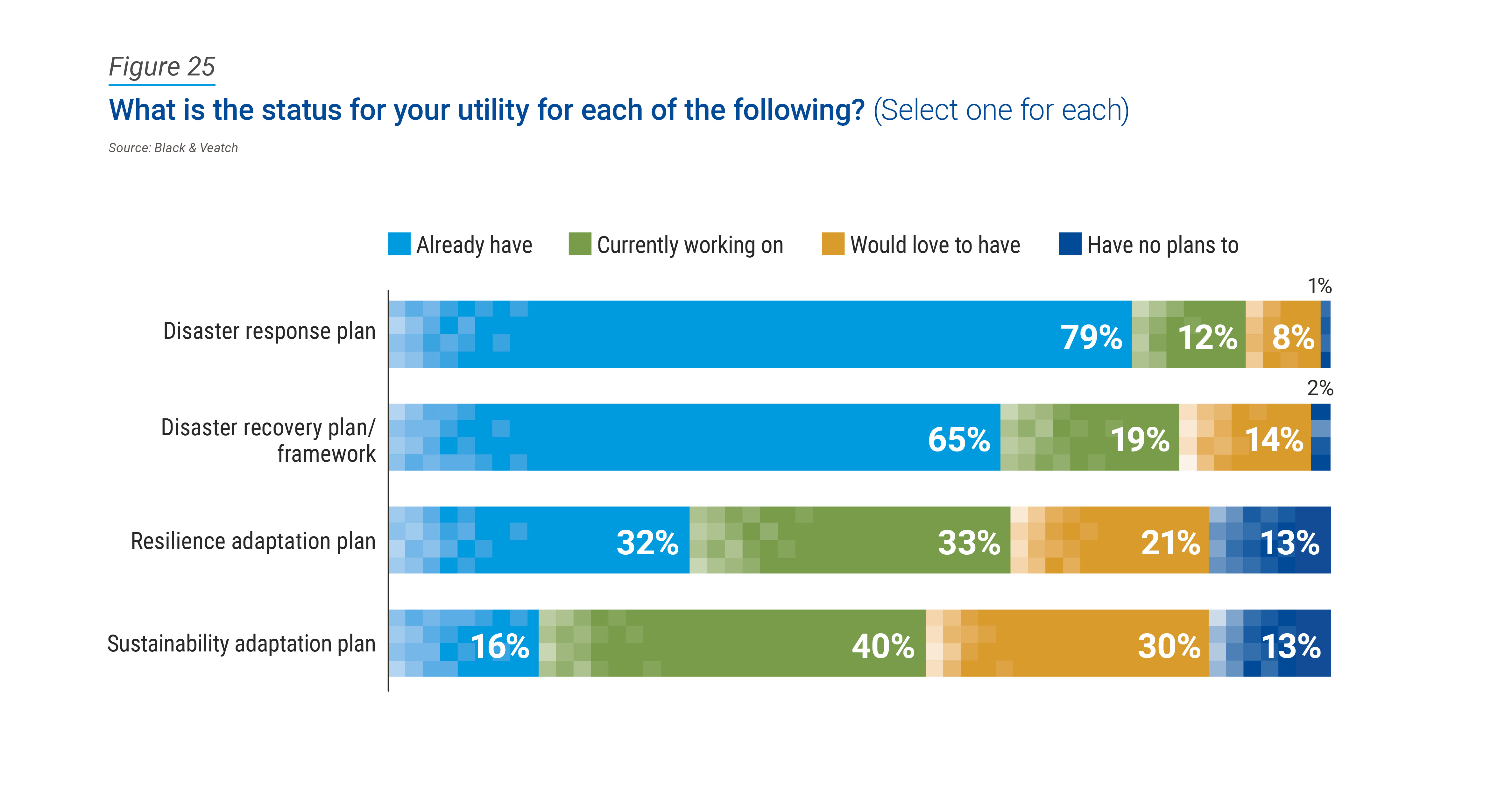
To adequately gauge how utilities can move forward in their response planning, survey respondents were asked what support is needed to advance a disaster response blueprint. The results may be unsurprising as slightly more than half — 53 percent — are seeking training and exercise and 52 percent are seeking planning and coordination (Figure 26).

The key takeaway to all of this: water utilities, while keenly aware of disruptive nature of climate change in the form of intensifying weather events, haven’t been as proactive as necessary when it comes to addressing the issue, for several reasons. Perhaps it’s because trying to see weather through a crystal ball is tough. Perhaps existing planning frameworks are not designed to deal with high impact or low likelihood events and uncertainties associated with climate change. Even as managing and maintaining aging infrastructure certainly continues to be a high priority, staffing and funding challenges of today may continue to take precedence over long-term planning.
One thing is clear: looking at past events to guide your decisions may be misguided, often leading to reactive approaches that don’t resolve the issue. Tools such as climate analytics platforms that help foster reasonable, smarter and more forward looking decision making about capital investments or asset hardening are out there.
Use them, and plan accordingly.
Flood-Prone, Seaside Charleston Pursues Next-Generation Water Plan, Enlisting Black & Veatch
Idyllically perched on a harbor inlet of the Atlantic Ocean, Charleston — with 157,000 residents, South Carolina’s biggest city and rapidly growing — has a rich, deep history that includes a long pattern of flooding becoming more pronounced with climate change.
And that 155-square-mile community is taking action by commissioning its first citywide flood prevention strategy in nearly four decades, turning to global water solutions leader Black & Veatch to guide their way to greater resilience.
Facing the threats of sea level rise and the impacts of high and king tides prominent along coastal seaboards, Charleston has enlisted Black & Veatch to draft a comprehensive, integrated flood mitigation roadmap that will help the city understand, plan for, prioritize, manage and adapt to current and future flood risks. The 25-year framework will include flood mitigating strategies for near- and long-term community resilience.
Often battered by hurricanes and the deluges they bring, Charleston looks to develop a carefully crafted plan to address its coastal threats and provide a blueprint for other coastal communities to advance their own resilience strategies.
Black & Veatch brings to the effort in-depth local knowledge about Charleston, given the global critical human infrastructure leader’s vast experience in leading the city’s most significant water-related plans and projects over the past two decades. The company’s service offerings include best-in-class national expertise from the water management, coastal and civil engineering, nature based design and community planning fields.
“Demonstrating its aspirational and bold vision, Charleston is among the coast’s first cities to begin innovative, forward-looking planning for and management of flooding, taking seriously the realities of climate change impacts that include sea rise and tidal surges,” said Stephen O’Connell, a Charleston-based project manager for Black & Veatch. “Charleston is steadfast in ensuring that its population and its guests continue to enjoy all that that scenic, historic city has to offer, and Black & Veatch will leverage its time-tested expertise to make that happen.”
For more information about Black & Veatch’s water solutions involving flood risk management, flood protection, resiliency and other topics, click here.
